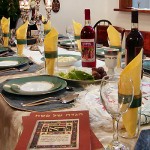The communal Seder
 Community Pesach celebrations began in Biblical days with groups joining (sometimes as an ad-hoc family) to eat the paschal lamb and ponder the Exodus.
Community Pesach celebrations began in Biblical days with groups joining (sometimes as an ad-hoc family) to eat the paschal lamb and ponder the Exodus.
By Mishnaic times there must have been a form of communal Seder, since the rabbinic sages debated whether one might go from one company (chaburah) to another on Seder night.
Community celebrations seem to have taken place on a regular basis in ancient and medieval Babylon and Spain.
In Ashkenazi countries some families brought in experts to run their Seder, which incidentally disproves the common view that every Jew was learned in Hebrew in olden days. Sometimes everyone repeated each word after the officiant, who would go from house to house to guide families in their festival observances, then return home for his own Seder.
There is telling evidence of community S’darim when the Jerusalem Talmud states at the end of tractate B’rachot, “He who has heard Hallel in the synagogue on Seder night has fulfilled his obligation.” The words “in the synagogue” could be interpreted broadly to indicate a public form of observance.
In the 14th century David Abudarham refers to a Babylonian or Spanish usage of a Seder in the synagogue precincts for those who were unsure of the festival procedures. Possibly it was not a full Seder but an entree, after which people would go home, eat a vegetable hors d’oeuvre (karpas), say the blessing “Who has redeemed us”, drink a second cup of wine, and proceed with the rest of the Seder.
This evidence indicates that there were always people whose Hebrew knowledge and Jewish skills were poor. It was regarded as important that no-one, child or adult, would be denied a Seder because of ignorance, age, illness or disability… and of course because of financial need.
Though communal S’darim sometimes take place in synagogue premises, the essential feature of Seder night is that it is not a public religious ritual that takes place in a publicly provided place of worship. Unlike, for example, a Shabbat service, it is not a ritual in which there are formal officiants with a supportive congregation. Seder is basically a family experience.
In his book, “A Feast of History”, Chaim Raphael compares it to the ancient free-wheeling talk feast in which everyone around the table is an active participant.
The difference between a Seder family and a congregation mounting a statutory act of worship is best seen when the Seder is observed at home, but the communal Seder brings together a larger, more varied family.



